Archived Water Damage Blog Posts
Post Water Leak Disinfection Process
11/3/2022 (Permalink)
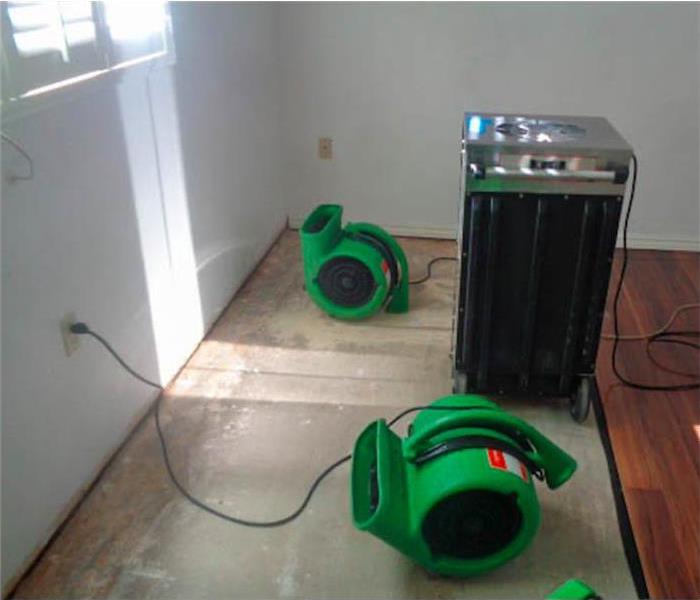 Use fans and dehumidifiers to dry the area quickly, and do not allow standing water to remain in the area.
Use fans and dehumidifiers to dry the area quickly, and do not allow standing water to remain in the area.
Post Water Leak Disinfection Process
Water leak disinfection is an important first step in the restoration process. It's also a critical part of preventing mold and other contamination from ruining your home or business. Here's what you need to know…
Removing soaked materials.
It is not just about getting the water out of your home; it's also about making sure you eliminate any bacteria or mold that might be present and keep your family safe. The best way to do this is by using antimicrobial products. They contain all-natural ingredients that kill germs, viruses, and other harmful microbes without leaving behind any toxic residue that could harm people or pets.
The first thing you should do after a leak is clear away furniture and belongings affected by water damage, so they don't encounter any contaminants. You should also turn off the electricity at the main breaker box before removing wet carpeting or insulation. Afterward, remove as much moisture from walls as possible using fans set on high speed—this will cut down on drying times later by reducing moisture levels in potentially damaged areas where mold can grow.
Drying out the structure.
The first step in the post-water leak disinfection process is to dry out the area. Use fans and dehumidifiers to dry the area quickly, and do not allow standing water to remain in the area. If you leave standing water in an area that has experienced a flood or other type of water damage, then mold spores can grow and spread throughout your home.
Then spray affected areas with antimicrobial.
Then spray the affected areas with an antimicrobial. Let it sit for a few minutes before wiping it off with water and drying it with a towel. Repeat if necessary.
This step is crucial to keep mold from growing back, especially if you have a large area of mold-affected drywall that needs cleaning up.
You see, drying is an important part of disinfection. Antimicrobial products need to be able to penetrate through the surface of your moldy sheetrock or flooring and kill any bacteria that have been growing beneath it. But if the area isn't completely dry before application (which may take days or weeks depending on how big the leak was) then water will get in between these layers and prevent the antimicrobial from doing its job properly.
Here's a procedure for a common first restoration task
- Dry the area out completely: Use a fan or dehumidifier to dry the affected area as much as possible before applying antimicrobial spray. This will help prevent mold growth and avoid having to deal with additional water damage later.
- Spray affected areas with antimicrobial spray: If you have any remaining mold, use an antimicrobial spray like Lysol or Clorox Clean-Up in conjunction with your existing cleanup efforts to disinfect each part of the room (and its contents) that was affected by water leakage during your home's leak detection process. We recommend using these sprays because they're easy to apply, non-toxic and effective at killing harmful bacteria.
- Let it air dry: Allow everything affected by water leakage during your home's leak detection process to dry completely before starting repairs (i.e., painting over mildewed areas).
Following these simple steps, you can not only restore your home to livable condition but actually prevent further problems!
What To Do When You Suspect a Broken Pipe
4/13/2022 (Permalink)
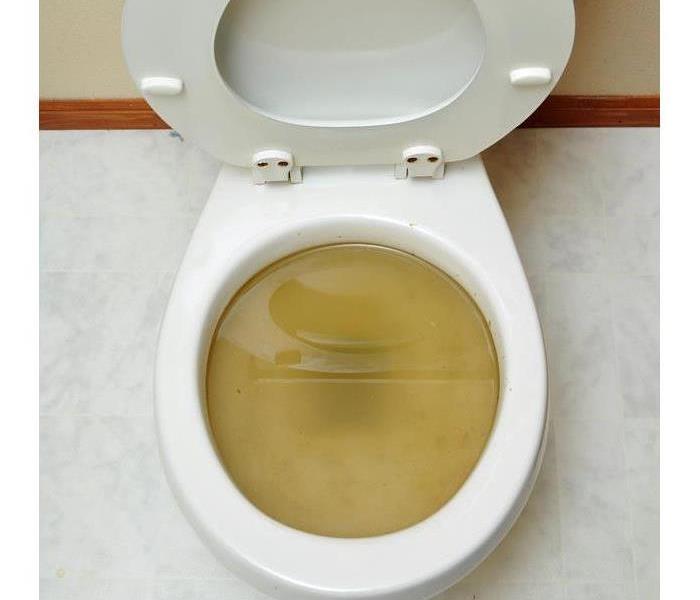 If you see raw sewage coming out in places such as your basement or faucets, it's best to contact your local sewage and water damage experts.
If you see raw sewage coming out in places such as your basement or faucets, it's best to contact your local sewage and water damage experts.
What To Do If You Think You Have A Broken Pipe
If you suspect a broken pipe, the first step is to locate the break. This can be easy to determine based on where you first noticed the signs. However, it could be located somewhere that you are not privy to as a residential home owner.
Read on to find out what to look for and how to mitigate as much damage as possible.
Signs of a Pipe Break
There are telltale signs of a broken pipe. Some include:
- Noises from walls
- Water leaks or flooding
- Musty smells
- Stains
- Water discoloration
- Lower water pressure or no water
- Increased water bill
Once you suspect that a pipe is indeed burst, you need to locate the break. It will either be in your home's plumbing system or in the public sewer system.
Breaks in the Sewer System
If the pipe break is in the sewer system rather than your residence, it can still affect you at home. Called a sanitary sewer overflow, this can contaminate:
- Water in home
- Lawns
- Consumable fish
- Air
- Documents
- Property
It can also cause flooding in the area. This likely isn't fixable directly by a home owner, but it is something to watch out for inside of your home. If you see raw sewage coming out in places such as your basement or faucets, it's best to contact your local sewage and water damage experts in Glendale, AZ.
Breaks in Residential Pipes
The pipe break can alternatively be in your home's plumbing system, and this requires a bit more vigilance on your part. As a home owner, you are responsible for paying for any damages incurred on your property. If you don't locate the source of the break quickly and get it resolved, you could run into major issues. Some causes of residential pipe breaks include narrowed pipes, freezing temperatures, or appliances overworking.
The good news is that you can watch out for the signs of a pipe break listed above. Then, professionals can identify the source of the issue before any lasting damage occurs. It's crucial to fix a broken pipe before it causes you to, quite literally, flush money down the drain.
Can My Carpet Be Saved After Water Damage?
3/4/2022 (Permalink)
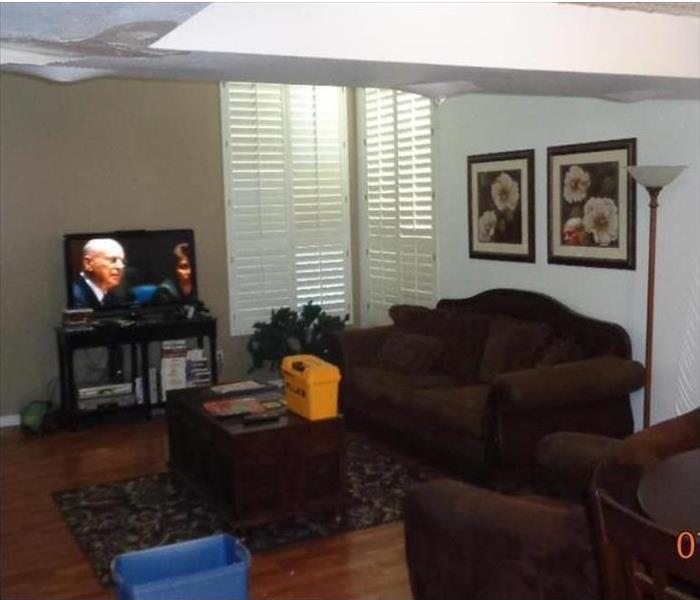 When your home requires water damage repair and restoration, our crew is here to help! We're standing by 24/7 to respond to your emergency
When your home requires water damage repair and restoration, our crew is here to help! We're standing by 24/7 to respond to your emergency
Is It Possible To Save My Carpet After It Has Been Flooded?
If your home in Peoria, AZ, has recently gone through water damage that affected your carpets, it doesn’t necessarily mean they need to be replaced. In the case of a pipe break, they could possibly be saved.
Types of Carpet Cleaning Services
When looking for a professional residential restoration company, you should be able to find a list of the types of services they provide. These may include the following treatments:
- Bonnet cleaning: This method is gentle enough for short-piled carpets.
- Hot water extraction: All types of carpeting can benefit from this cleaning technique.
- Dry cleaning: This may be necessary when there are color-fastness issues.
- Showcase premier cleaning: Known as one of the most thorough cleaning methods, it’s best for highly-soiled flooring.
- Deluxe precondition and rinse: This will deep-clean and restore your carpets.
A typical carpet cleaning should include extracting the moisture, sanitizing the area and drying it. These procedures should bring most carpets back to life, depending on the condition they're in.
How To Know Whether To Restore or Replace Your Carpets
Carpets are highly absorbent, so when water damage occurs, it’s normal to replace them with new flooring. However, if the cause of damage is from a clean water source such as a pipe break, it’s possible to have it cleaned and restored to its original condition. In some cases, the carpet may be even cleaner than before, which could improve your family’s health.
In the event of gray or black water contamination, your carpets should be replaced since it’s highly likely that the water will contain bacteria that can affect your home and health. The longer that your carpeting is saturated, the more likely it could lead to mold, mildew and unpleasant odors.
If there is a pipe break in your home that has damaged your carpet, you may be able to rescue it through a professional restoration service. Although you may be able to clean some of the affected areas yourself, it’s always a good idea to contact a team of professionals who can ensure that your carpets will be safe from any further damage.
What Homeowners Should Know About Secondary Damage
2/4/2022 (Permalink)
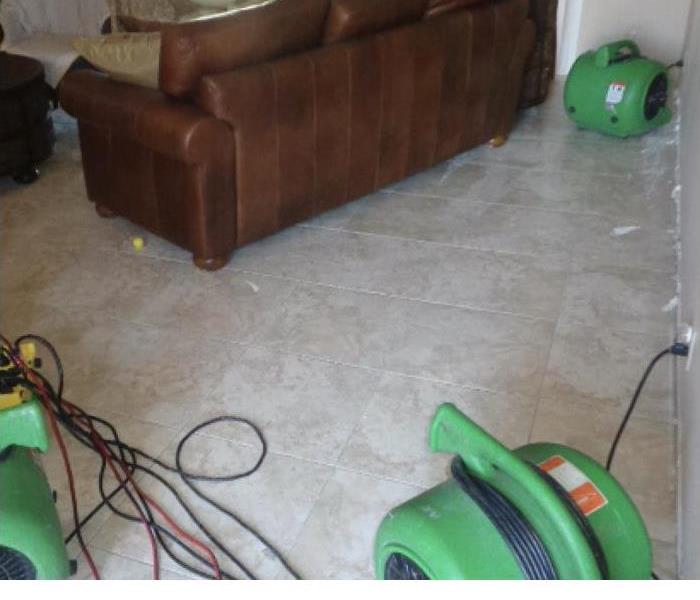 This homeowner called SERVPRO for help and we were able to arrive quickly and begin drying out the area immediately. Call us when you need it.
This homeowner called SERVPRO for help and we were able to arrive quickly and begin drying out the area immediately. Call us when you need it.
Secondary Damage: What Every Homeowner Should Know
When water damage occurs in your residence, quick action is critical. Even after the leak or flood that caused the initial destruction has ended, secondary damage, such as black mold, can still occur if the property is not effectively dried and treated. If your home in Weedville, AZ, has sustained water damage, taking the following important steps can help you protect your home.
1. Extract the Water
Mold can grow in as little as 24 hours, so your home should be dried out as quickly as possible. Extract all standing water and make sure all surfaces are free of moisture. If the area is small, then a wet/dry vacuum may do the job, but more extensive water may require the use of professional-grade equipment.
2. Lower Humidity
High humidity can also encourage mold growth, so open the doors and windows, and run fans in each room. Dehumidifiers can be utilized to further decrease moisture and water vapor in the air.
3. Remove Wet Items
Porous materials, including carpets, rugs, insulation, furniture and upholstery, should be removed as quickly as possible to inhibit black mold from growing.
4. Sanitize and Disinfect
All exposed surfaces should be thoroughly cleaned with commercial-grade products and disinfectants to remove the dirt and bacteria that provide nutrients for mold.
5. Monitor the Area
After your home has been dried and cleaned, you will need to watch closely for any signs of mold. Obviously, visible mold can be easily identified as a problem, but mold can also grow in areas that can’t be easily seen. You should thoroughly check darker areas that are prone to dampness. Look out for any musty odors that may smell similar to mildew.
If you suspect you may have black mold in your home, or if you’re unsure how to effectively clean after water damage, contact a mold remediation specialist to resolve any problems and help you avoid costly secondary damage to your property.
8 Steps To Take When Flushing an Electric Water Heater
1/7/2022 (Permalink)
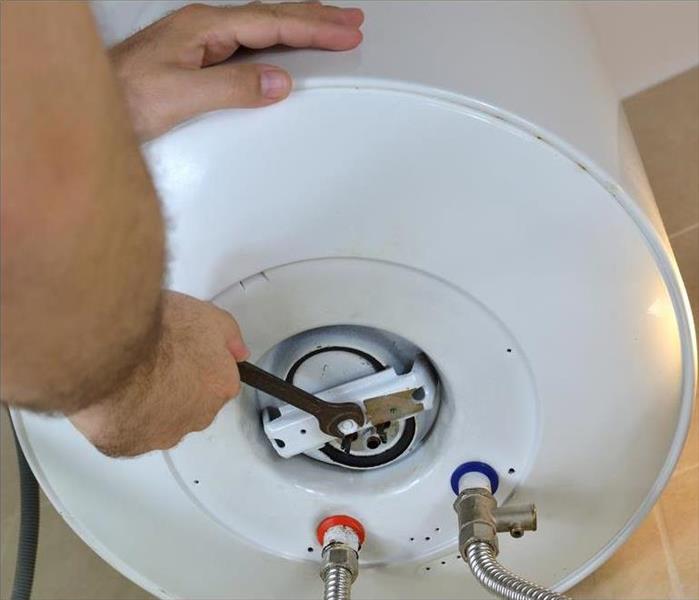 Your home can benefit from the expertise of water damage restoration professionals, SERVPRO is always here, ready to respond to your needs, call us!
Your home can benefit from the expertise of water damage restoration professionals, SERVPRO is always here, ready to respond to your needs, call us!
When Flushing An Electric Water Heater, Follow These 8 Steps
Hidden away in the garage or a closet is one of your home’s appliances that many people consider an essential part of modern life. Though it is often ignored for years, rarely dusted or checked, it is used in most residences multiple times a day. It’s the water heater.
So, what do you do when this important appliance begins making thumping, popping, or creaking noises? Although it may have a long life in West Glenn Estates, AZ, most heaters need your help in removing the sediment that can become trapped in the bottom pan. Here is how to do a water heater flush.
1. Cut the Power
Make sure you turn off any electricity moving into the heating unit before taking any further steps. This will prevent damage to the heating elements.
2. Turn off the Water
Shut the valve feeding water into the tub of the unit. There is often an inlet at the top of the tank that can easily be closed.
3. Begin to Drain
Attach a hose to the drain valve at the bottom of the water heater. Be sure it is secure to prevent leaks.
4. Open the Spigot
Open the pressure relief control and the spigot. This will allow the tank to drain.
5. Remove the Water
Be patient while the water drains. It may take several hours to remove all the liquid.
6. Close the Valves
When the tank is empty, close the drain valve and disconnect the drain hose. Now close the pressure relief control valve.
7. Open Hot-water Faucets
Open every hot water faucet in your home, except the tank’s. Then turn on the inlet at the top of the tank and allow the water to flow freely out of the faucets for at least three full minutes.
8. Close All Faucets
When the tank is full of water once again, close the spigots. If you have low water pressure, let the water run for more than three minutes. Call a water specialty team if you have concerns.
Restore power and use your water heater as normal. By cleaning the sediment from the bottom, you may have added years to the unit’s life.
If Your Water Heater Has a Leak, Read This
12/2/2021 (Permalink)
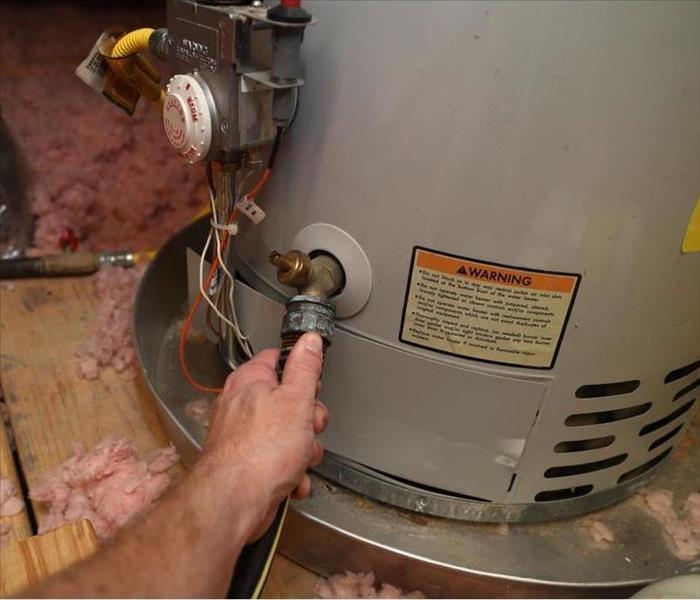 When a leaking water heater causes a flood, you must determine which of your keepsakes are salvageable and which ones are garbage.
When a leaking water heater causes a flood, you must determine which of your keepsakes are salvageable and which ones are garbage.
Read This If Your Water Heater Is Leaking
Water is essential in every home in Peoria, AZ. When water stays where it is supposed to stay, you usually don’t have to think much about it. On the other hand, whether you have a small leak or a large flood, water can ruin the comfort, value and appearance of your home. As you may suspect, a leaking water heater can make a huge mess. If you have to deal with a failed water heater, consider following these four simple steps.
1. Disconnect Electrical Devices
Water and electricity do not mix. If your broken water heater causes significant flooding, you must be certain you do not leave electrical devices connected to sockets. When disconnecting them, you must take care not to shock yourself. If you are worried about your safety, ask for professional assistance.
2. Throw Away Damaged Items
Many homeowners use the area around their water heaters for storage. When a leaking water heater causes a flood, you must determine which of your keepsakes are salvageable and which ones are garbage. If some of your treasures have sustained damage, ask a reputable flood restoration specialist to help you make the determination.
3. Dry Wet Areas Immediately
Mold can grow in as few as 24 hours. As such, it is important to completely dry wet areas as soon as possible. If you already have mold growth, you may need to rely on a mold mitigation service to contain the spread of black mold.
4. Think About the Air
Floods usually cause the humidity in the space to rise significantly. Accordingly, you may need to use a dehumidifier to effectively remove water from the air. A hygrometer can tell you whether your house has abnormally high humidity.
Because a leaking water heater can wreak havoc on the condition of your home, you want to pay special attention to the area around your water heater. If you notice a leak, you must act quickly to contain damage, repair damaged areas and stop mold growth.
2 Things Not To Do After Water Damage to Your Home
11/1/2021 (Permalink)
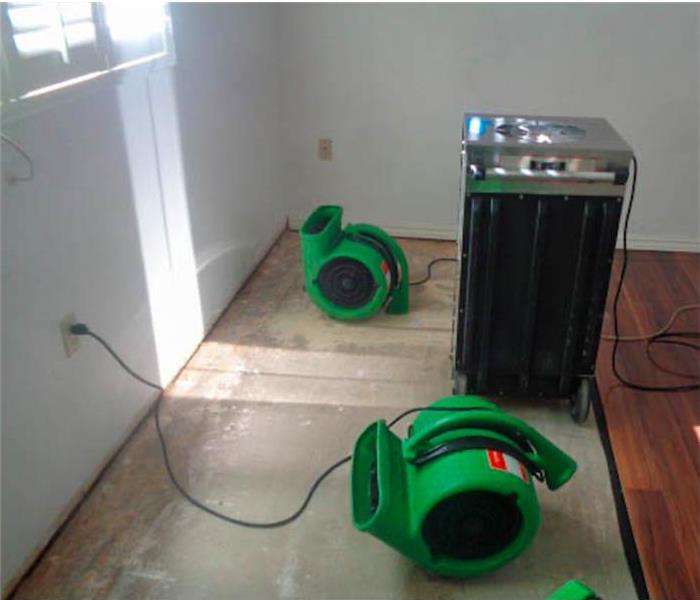 This home had suffered from moderate damage after a water leak in their home, but SERVPRO responded quickly. Call us!
This home had suffered from moderate damage after a water leak in their home, but SERVPRO responded quickly. Call us!
2 Things You Shouldn't Do If Your House Has Been Flooded
When your home has suffered extensive water damage after a broken pipe or flooding, your first instinct may be to start cleaning up the mess. As strange as it sounds, this may not be the best course of action. If you plan on filing a claim with your insurance company, you’ll need to provide evidence of the damage and get approval before making any repairs. Not only that, hiring a professional water damage mitigation service in Weedville, AZ, to handle the clean-up and restoration of your home can save you time and money.
1. Don’t Throw Anything Away
Before you throw away any possessions damaged by a broken pipe or flood, you’ll need to photograph or video them, record their make, model, age and condition and allow a claims adjuster to inspect them. It’s also worth letting a water damage expert assess the damage too. They have specialized equipment for drying, cleaning, deodorizing and restoring everything from furniture to photographs, so there’s a fair chance they can salvage damaged possessions.
2. Don’t Try To Remove the Water Yourself
As distressing as it is to see so much water in your home, don’t try to get rid of it yourself. Again, you’ll need to have the damage assessed by an adjuster before you begin clean-up. When you contact your insurance company, talk to them about hiring your own public adjuster to do the assessment as a way to speed the process along.
Experts in water damage mitigation have access to specialized equipment that will make water removal faster, more efficient and much easier than anything you can do on your own. Their industrial de-humidifiers and fans can dry out your belongings before they begin to grow mold, saving you the cost of replacing furniture and carpets.
It’s easy to panic when a broken pipe or other disaster floods your home, causing extensive water damage. Whatever you do, however, don’t throw anything away or try to remove the water yourself until you file an insurance claim and talk to an expert in water damage mitigation in Weedville, AZ.
The Hidden Cost of Leaks
8/30/2021 (Permalink)
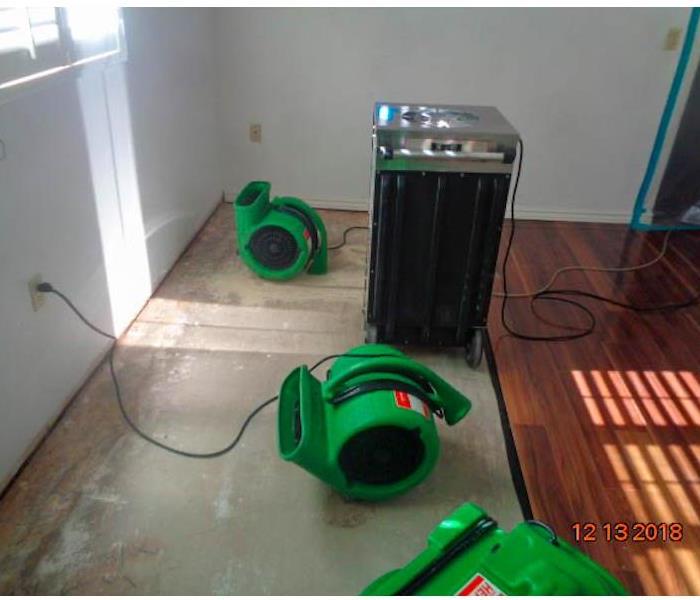 Protect your business from high bills and water damage by conducting regular inspections and having leaks fixed before they become a big problem.
Protect your business from high bills and water damage by conducting regular inspections and having leaks fixed before they become a big problem.
You get your water bill for your commercial property in Peoria, AZ, and you can't believe the number you see. Large spikes in utility bills are often the first signs property owners notice that they have a water leak in their building. Whether the leak comes from inside or outside the property, it will need to be fixed, or over time you may lose thousands of dollars due to heftier water bills.
Inside the Building
With miles of pipe running through your building, it is likely that at some point a leak is going to happen. Some of the most common interior leaks include:
• Leaky toilet caused by a faulty flapper in the tank
• Leaky faucet caused by a faulty washer or loose handle
• Pipe break in the walls
• Loose or broken supply line
If you have a water leak inside your building, it not only drives up your water bill, it can also cause significant water damage or even a mold problem if it goes undetected. Then you will have the added cost of water remediation services to add to the list.
Outside the Building
You may have even less control over what goes on outside your building. If your irrigation system is leaking, you may not know it until you get that high bill if you are not conducting routine checks. If the lateral line to your meter is cracked, it can affect the area around your foundation. Look for unusually wet places on the lawn or near your meter or suspicious pooling of water anywhere on your property. If you find such space during your inspections, contact professional remediation experts to find and fix the leak.
A water leak can cost you a lot of money if it goes undetected. Protect your business from high bills and water damage by conducting regular inspections and having leaks fixed before they become a big problem.
Timeline for Water Damage Restoration
7/15/2021 (Permalink)
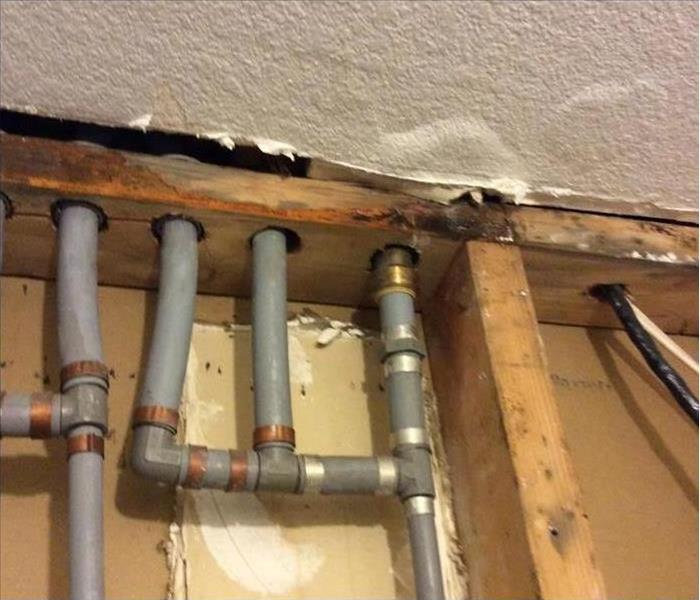 Leaking pipes can cause damage to your home in West Glenn Estates, AZ.
Leaking pipes can cause damage to your home in West Glenn Estates, AZ.
Water Damage Restoration
After bursting pipes flood your home in West Glenn Estates, AZ you respond immediately by calling water restoration experts. Now that you have that step out of the way, how long does the rest of the process take?
Immediately
It is critical to fix the broken pipe as soon as you notice it, as water damage continues to occur until the source is repaired or replaced. The process of cleaning, drying and restoring then begins:
• Water restoration companies have emergency service hours of operation, typically staffed 24 hours a day. As soon as possible, contact the company to arrange for someone to come out to your home. In addition, check with your insurance company to inquire about coverage.
• Within four hours, the professionals arrive to evaluate the extent of the water damage. They also assess the situation for safety, including whether electricity poses a risk. The type of water is identified, as the procedure for clean versus contaminated water varies in complexity and impacts the treatment and timeline.
• Excess water removal begins quickly to minimize any further damage, using professional grade pumps and vacuums.
The Next Few Days
During the next three to five days, expect the following actions to take place:
• Once the excess water from the bursting pipes is gone, your home is inspected for hidden moisture with specialized equipment. Carpets and drywall may be removed.
• Industrial strength dryers and dehumidifiers thoroughly dry the area.
• Depending on the level of contamination, antibacterial and odor removal steps may be taken to properly sanitize your home.
• In some instances, the process may take a little longer. For example, drying wood floors may take up to ten days. Excessive contamination caused by sewage may take longer for disinfection and safety reasons. The restoration process of returning your home to preloss condition depends of the extent of the damage.
Take immediate action if bursting pipes threaten your home in West Glenn Estates, AZ. With fast and proper action, you can achieve a dry home typically within five days or less with the help of a water restoration specialist.
How To Flush Your Water Heater
3/11/2021 (Permalink)
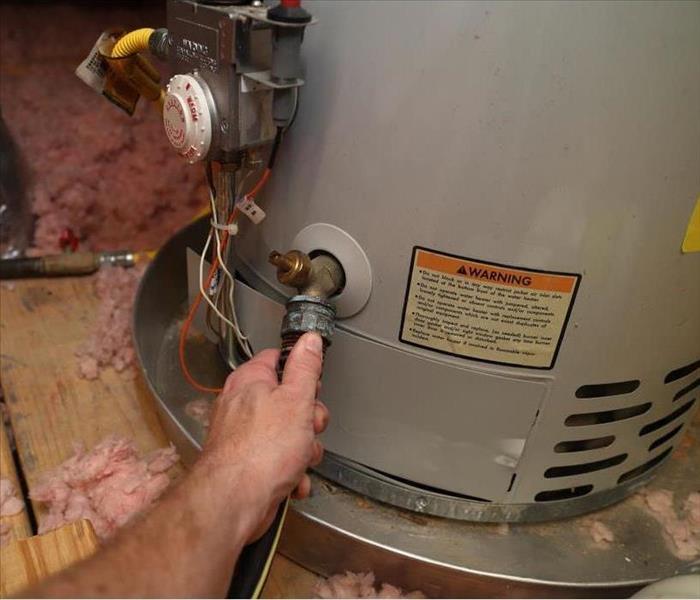 Water heater flush.
Water heater flush.
Steps To Flush A Water Heater
You might not think much about your home's water heater unless it interferes with your plans to take a hot bath or perform daily tasks requiring hot water at your home in Grand Manor, AZ. An annual water heater flush involving these steps can ensure that this indispensable appliance works when you need it most.
Turn off the Power
It is essential to turn off the gas or electricity that powers the appliance before doing anything else. For a gas heater, you should first adjust the thermostat knob, usually located at the bottom of the tank, to the off position. For electric heaters, you will need to flip the power switch at your home's circuit breaker box.
Connect a Garden Hose
Attach one end of a straightened garden hose to the spigot at the tank's bottom and open the tank's hot water release valve. The hose's other end should point directly into the basement floor drain, close to your water heater. You can also use a pump to direct the water's flow outside.
Turn on a Hot Water Faucet
Once the hose is secure, you can turn on the hot water faucet of any upper-level sink to force water out of the heater's tank. It may take anywhere between 20 minutes and one hour before all the hot water drains.
Begin the Water Heater Flush
You can now open the heater's cold water valve and turn on a cold water faucet elsewhere to flush sediment particles out of the tank until you see clear water flowing.
Refill the Tank
Shut off the tank's cold water valve will allow it to refill with water. You will know that the tank is full when water flows from the hot water faucet that is still on, and you can now turn it off.
Reactivate the Power
You can now reactive the gas or electricity to heat the water in the tank.
If your water heater causes a flood despite proper maintenance, a local disaster restoration service can cleanup your home in Grand Manor, AZ.
How Can Wet Documents Be Restored?
2/11/2021 (Permalink)
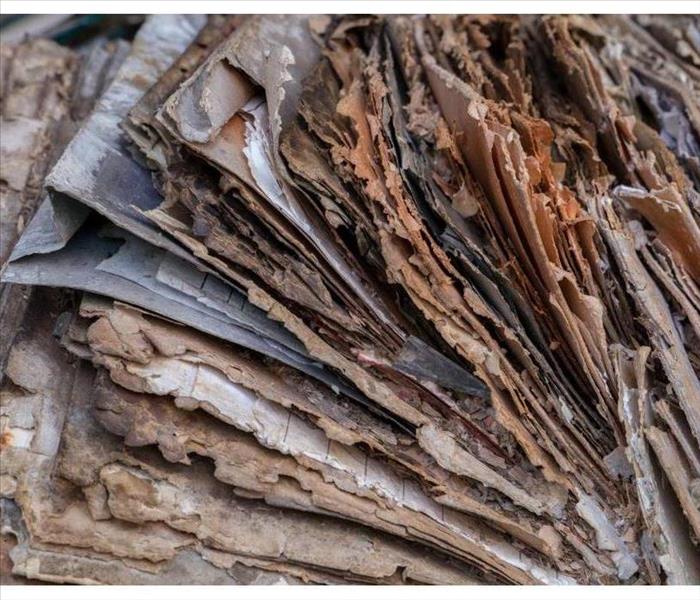 If a flooded building leaves you with wet documents, all is not necessarily lost.
If a flooded building leaves you with wet documents, all is not necessarily lost.
How Can Wet Documents Be Restored?
If your building floods, there’s a chance that some of your most important documents could be damaged. Losing key records, original documents, books, and photos can be one of the most devastating effects of flooding. Fortunately, with specialized technology and innovative techniques, restoration professionals can often salvage and even restore wet documents.
1. Transfer to Restoration Facility
First, a document restoration team transfers wet and water-damaged documents to a secure restoration facility. These facilities are typically subject to 24-hour surveillance and are managed by HIPAA-Master-certified restoration technicians. Once they arrive at the restoration facility, water-damaged documents, and paper goods are carefully separated, inventoried, and cataloged to ensure nothing is misplaced or out of order.
2. Freeze-Drying
Next, restoration specialists use a unique vacuum freeze-drying process to dry the documents. This process is the same method that the U.S. Library of Congress uses for valuable books and historic documents and is the only document restoration process that is currently approved by the National Archives and Records Administration.
This specialized document drying technique can be used to safely restore many types of wet documents and paper goods, such as:
- Books
- Files
- Photographs
- Maps
- Magazines
- Manuscripts
- Blueprints
- Film and microfiche
- Parchment
- X-Rays
- Negatives
3. Gamma Irradiation
Most floodwater contains at least some contaminants, such as dirt, pesticides, bacteria, chemicals, and viruses. These contaminants may not be visible to the naked eye, but they can penetrate documents and cause ongoing damage. Restoration professionals use a state-of-the-art gamma irradiation procedure to clean, sterilize, and deodorize important documents without causing further damage.
4. Digitizing
Finally, the document restoration team carefully scans each document to create a high-quality digital copy. These digital versions are then added to the initial computerized inventory and cross-referenced, creating a convenient and searchable document catalog.
If a flooded building leaves you with wet documents, all is not necessarily lost. Contact an experienced document restoration company near Weedville, AZ, right away for the best chance at restoring these valuable items.
Tips for Water Damage Claims
1/14/2021 (Permalink)
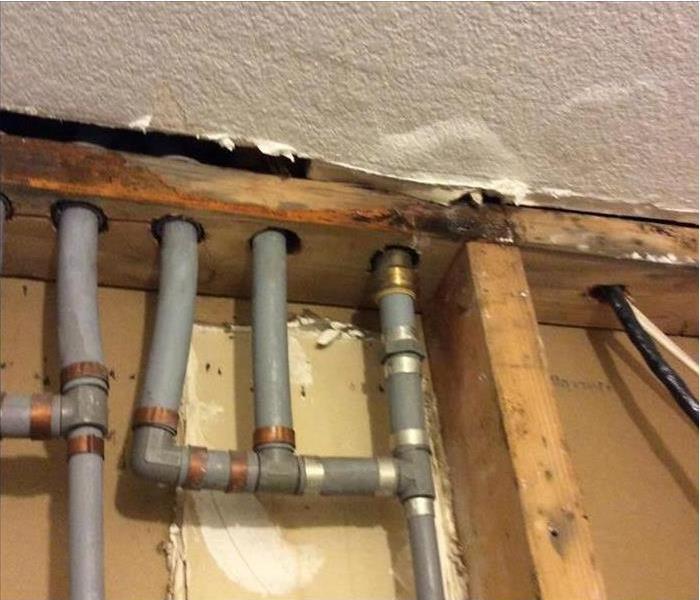 Bursting pipes are unexpected and cause havoc
Bursting pipes are unexpected and cause havoc
Bursting pipes are unexpected and cause havoc. Cleanup and repairs can be costly. If your home in West Glenn Estates, AZ, suffers damage from a burst pipe or flood, you'll likely want to make a claim with your insurance provider to help recover the costs of your repairs.
Tips to Avoid Having a Future Claim Denied
Many water damage claims are denied by insurance because the damage is determined to be gradual damage that happened over time. To help your chances with any future damage claims from bursting pipes or similar sudden and unexpected events, follow these tips as you maintain your home.
Keep records of all repairs made over the years
Keep records of all the professionals you hire to do maintenance
Know your responsibilities as a homeowner
Do regular home maintenance every spring and fall
Take care of small repairs as they arise before they become larger problems
Have a clear understanding of your policy, its coverage, and its exclusions
Make sure you purchase an insurance policy that covers your needs
Inquire about extra coverages that will be useful for you and your property
Understanding Gradual Damage
Gradual damage is any damage that was caused over a period of time. For example, plumbing gradually leaking into the walls or floors. Even though you may have been unaware of it, it happened over time. This type of damage may have been preventable had you practiced regular home maintenance and inspected your plumbing. Insurance generally only covers damage caused by sudden and unexpected events. Your failure to fix a broken pipe you were, or should have been, aware of will likely not be covered.
There is no way to plan for the damage caused by bursting pipes. Restoration experts can help you clean, sanitize, restore, and rebuild if necessary. Insurance can help you financially recover from the costs incurred to make repairs. Check with your insurance provider to see what is covered under your policy.
What To Do If Your Water Heater Is Leaking
11/20/2020 (Permalink)
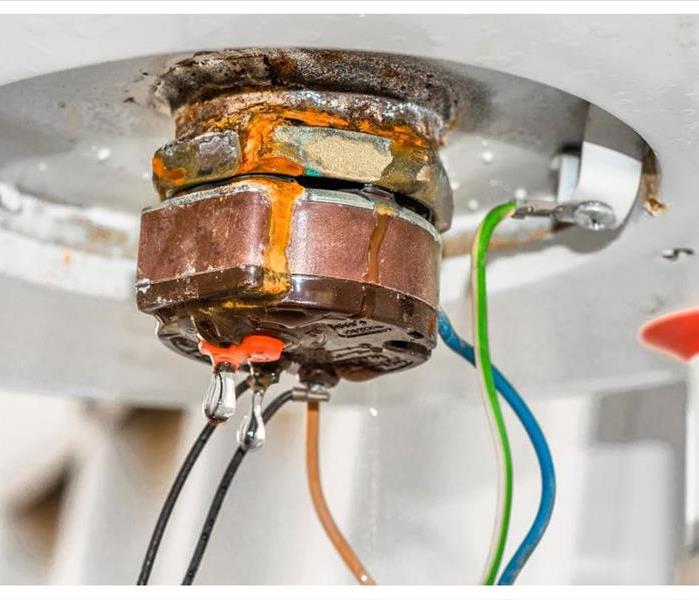 A leaking water heater can cause a lot of damage
A leaking water heater can cause a lot of damage
Leaking Water Heater?
A leaking water heater can cause a lot of damage. Water heaters in Glendale, AZ, homes tend to be tucked away out of sight in basements or closets, which means leaks can go undetected for a long time. Water left standing can damage your floor, subfloor, insulation and more. Moisture can seep into drywall and flooring materials, leading to excess mold growth. Depending on the severity and duration of the leak, you may need to call a cleanup team to address the damage.
1. Stop the Leak
When you have a broken water heater, the first thing you should do is stop any new damage from occurring. Disconnect the power to the heater and shut off the water supply. You may need to drain the heater so that no more water can leak out. Do this by connecting a hose to the heater’s drain valve. Use towels or a shop vacuum to remove any standing water.
2. Assess the Damage
Once the leaking has stopped, you’ll need to assess the situation and figure out:
- whether to repair or replace the leaking
- water heater
- how much damage resulted from the leak
- what cleanup measures are necessary
You may need to contact a plumber or other technician to determine the best course of action for repairing the failed water heater. Depending on the extent of the water damage, you may need to contact water remediation professionals.
3. Clean and Disinfect
If the heater was leaking for some time, moisture has likely seeped into nearby drywall, baseboards, wood floors and/or carpeting. Where there is moisture, you can expect to find mold growth, even if you can’t see it yet. Remove any wet drywall and flooring materials. The studs and subfloor must be fully dried and sanitized to prevent a future mold problem.
As soon as you discover a leaking water heater, it’s important to act quickly to minimize the damage. A professional remediation service may be necessary to eliminate mold and restore your belongings.
3 Signs It's Time To Replace Your Bathroom Supply Lines
10/9/2020 (Permalink)
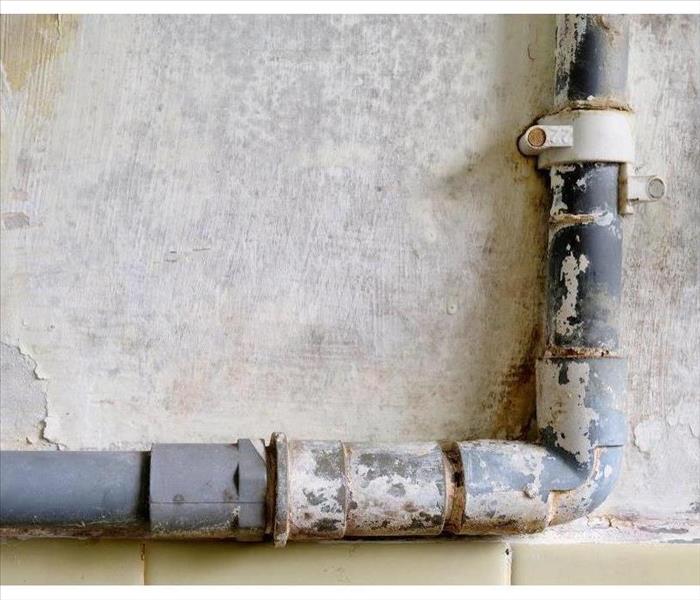 Fortunately, with a little maintenance, you can prevent supply line damage
Fortunately, with a little maintenance, you can prevent supply line damage
It's Time To Replace Your Bathroom Supply Line
A flooded bathroom can require serious water damage restoration efforts. Most bathroom leaks are due to supply line damage. Supply lines bring fresh water into your sink, toilet, and washing machine (if it’s in your bathroom). Inspecting and maintaining these lines is an easy way to prevent a costly disaster. Here are three signs it’s time to replace your bathroom supply lines.
1. They’re Made of Plastic, or Non-Braided Metal
Plastic supply lines are prone to leaks and don't last long. They need to be replaced at least every five to eight years. Supply lines made from semi-flexible, non-braided metal wear out quickly and tend to kink, causing pinhole leaks. This type of supply line was common in older homes in Glendale, AZ, and should be replaced.
Lines made from braided steel are your best bet to avoid supply line damage. These lines typically have a lifetime warranty and are widely recommended by plumbing experts. Pro tip: Make sure that you choose the kind that have brass nuts, rather than plastic nuts.
2. You Notice Any Signs of Leaks or Visible Wear
Watch out for any signs of a supply line leak, such as water stains, a musty or mildew smell, or an unexplained increase in your water bill. It’s a good idea to inspect your supply lines and valves every six months. Pro tip: Check your supply lines on the same days you change your clocks for Daylight Savings Time.
3. It’s Been Longer Than Five Years (for Washing Machines)
Braided-steel supply lines to the toilet and sink supply can last a lifetime, but washing machine supply lines need to be replaced much more frequently, due to the strain caused by pressure cycling and vibration from the machine. Washing machine manufacturers recommend replacing the supply line every five years. Pro tip: Leave some space behind your washing machine so you don’t force a kink in the line.
No homeowner wants to experience a bathroom leak. Fortunately, with a little maintenance, you can prevent supply line damage and avoid a catastrophe.
A 3-Step Disaster Preparation Plan
8/31/2020 (Permalink)
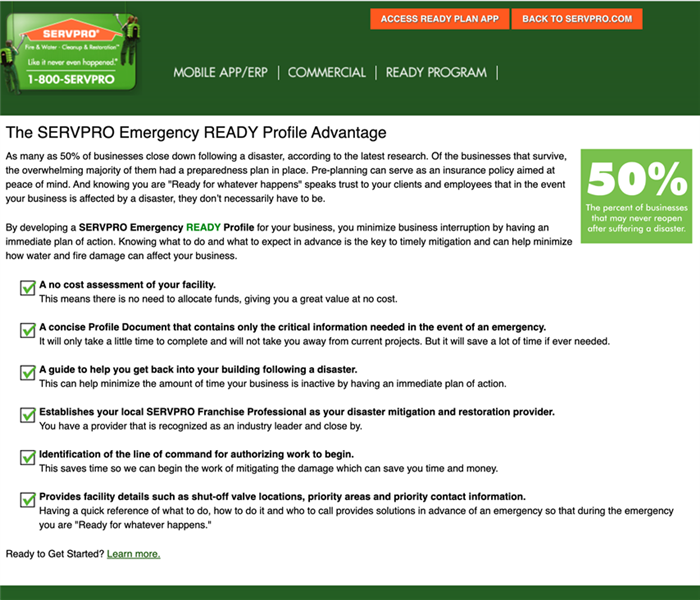 Create an emergency ready profile for your business
Create an emergency ready profile for your business
How To Create An Emergency Profile
Most businesses run based on plans. Business owners should also plan ahead for disasters that can affect or undermine daily operations at any location. In the event of a disaster, it is important to know exactly what you can do to limit and restore damage to a commercial property. Find out how to create an emergency profile with a trusted restoration company for a building in Weedville, AZ.
1. Create an Emergency Ready Profile
Contact the nearest SERVPRO franchise to your business or commercial property. A trained representative will guide you through the process of creating a profile through the ERP app. You can access and update the profile you create through the same interface and use the app to arrange for damage inspection and mitigation.
2. Inspect, Test and Maintain Safety Systems
An emergency profile should account for the safety systems in place at a commercial property. This profile cannot account for the condition of these systems or guarantee that fire suppression equipment or automatic water shutoff mechanisms are functional. It is the responsibility of a business or commercial property owner to ensure that all safety systems stay up to code and operational.
3. Develop Emergency Response Plans
A business should also have emergency response plans for evacuation and managing critical systems in the event of a disaster. Some of these measures may be accounted for in a commercial profile. It is important to regularly train employees or building occupants in emergency procedures and do drills to allow for the highest level of safety.
Starting to take these steps today can make it easier for a business or commercial property owner to deal with disasters down the road. Owners may have more peace of mind knowing that an accurate and up-to-date emergency profile is on file with the nearest franchise location of a major restoration company in Weedville, AZ.
Tips for Cleaning a Flooded Basement
5/26/2020 (Permalink)
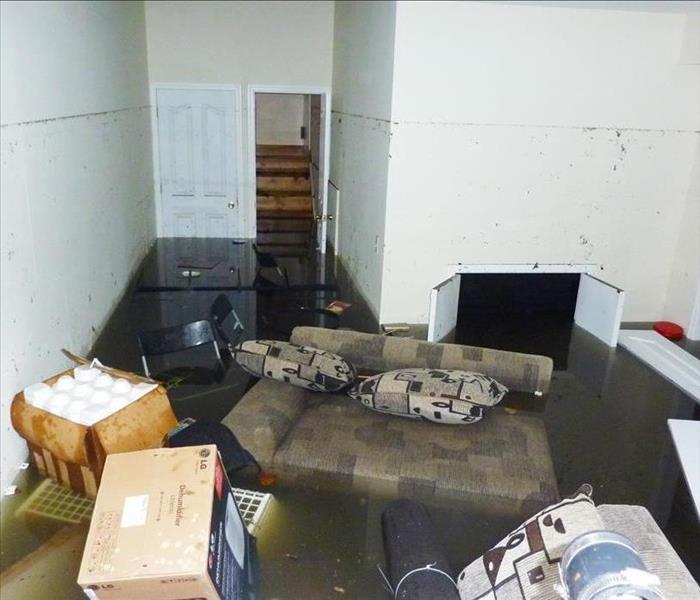 Flooded basement in Glendale, AZ
Flooded basement in Glendale, AZ
Tips for Cleaning a Flooded Basement
A basement flood is a big problem and can happen for many reasons. It could be the result of a slow, soaking rain, a quick, heavy downpour, a broken pipe, or for some other reason. When it does happen, certain principles should be followed to remedy the situation. Always keep in mind these timeless principles:
- Think safety first
- Be aware of electrical hazards
- Keep children, pets and family members away from the water
- Assume the water is contaminated with unhealthy substances
- Remove water before entering the basement
Whenever a property owner or renter is faced with a large water event, he or she should consider the services of a professional water remediation team. Highly-trained technicians will have the experience and the equipment to handled flooded areas of a home.
Basement Flood
In addition to the possibility of electrical hazards, a flooded basement can pose other perils. Occasionally, the water in a home in Glendale, AZ, might contain wild, trapped animals. Everything from rats and snakes to opossums and raccoons could be floating on the top of the water, looking to escape. More often than not, depending upon the water source, a flood contains dirty water that should be approached with caution. Water from outside the home should be suspected of carrying germs, chemicals, and other harmful materials. If the water comes from inside the home, such as a broken sewer line, the water is equally suspect and should be avoided except by professionals with personal protective equipment.
Insurance Coverage
As soon as is practical, victims of a basement flood should look into their insurance situation. Floods caused by rain and storms are covered by special flood insurance that is typically purchased through the federal government. A big water event that is the result of a sudden, catastrophic breaking of a water pipe or some other plumbing problem is often covered by a regular insurance policy.
Common Water Problems That Building Owners Deal With
5/11/2020 (Permalink)
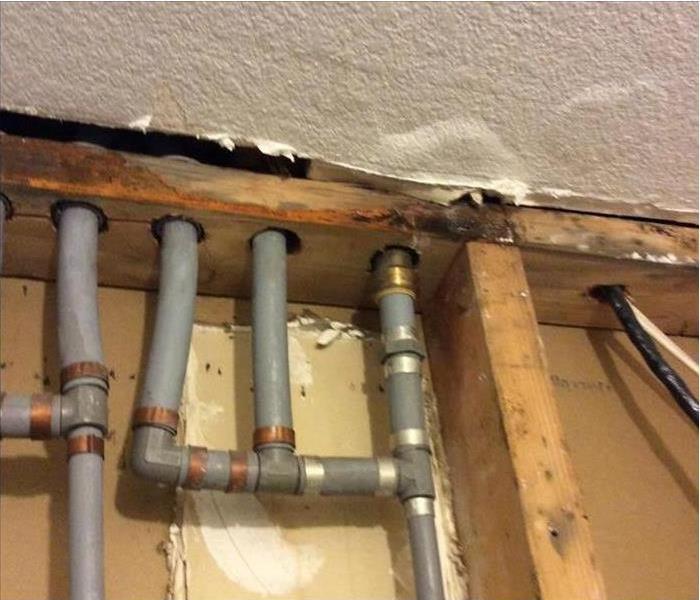 Pipe leak in a Grand Manor, AZ building
Pipe leak in a Grand Manor, AZ building
Typical Types of Water Damage That You Could Experience
Water is an essential commodity for everyone. You need it at home, and you rely on it in the workplace, no matter what your business does. However, water can also be destructive if it's not used correctly or contained. In a commercial building, plumbing issues can cause widespread damage. With it's leaking pipes or something else, you should recognize some typical types of water damage that you could experience.
Pipe Leaks
Perhaps the most frequent sources of water damage, a leaky pipe can rot wood and drywall. This can also cause mold and ruin electronics, furniture, documents, and other materials. One of the challenges with leaking pipes is that this issue could go on for weeks or even months before you notice it. Over time, constantly dripping water under sinks and in walls or ceilings could be devastating. Here are ways to prevent pipe leaks:
- Have a plumber inspect your pipes and plumbing system once a year.
- Repair and replace broken pipes immediately.
- Make sure to use high-quality materials in your plumbing system.
Pipe Burst
While a leaky pipe can gradually ruin building materials and encourage mold growth, a pipe break can introduce a massive flow of water into your Grand Manor, AZ, building. A pipe burst often occurs when a pipe is weak, worn out, or decayed. Cold temperatures can also freeze pipes, causing them to break and expel hundreds of gallons into your building.
Overflowing Toilet
A toilet backup could be as simple as someone using too much toilet paper, but the issues are often deeper. A blockage could occur far down in the line. There may also be a problem with the main sewer line coming into your building. Cleaning up after a toilet overflow may require the efforts of a professional flood remediation team. Certified technicians can safely remove black water from your building and restore destroyed items.
Be aware of these potential water problems at work. Make sure you properly monitor and maintain leaking pipes and these other systems.
5 Steps of the Water Cleanup Process
2/14/2020 (Permalink)
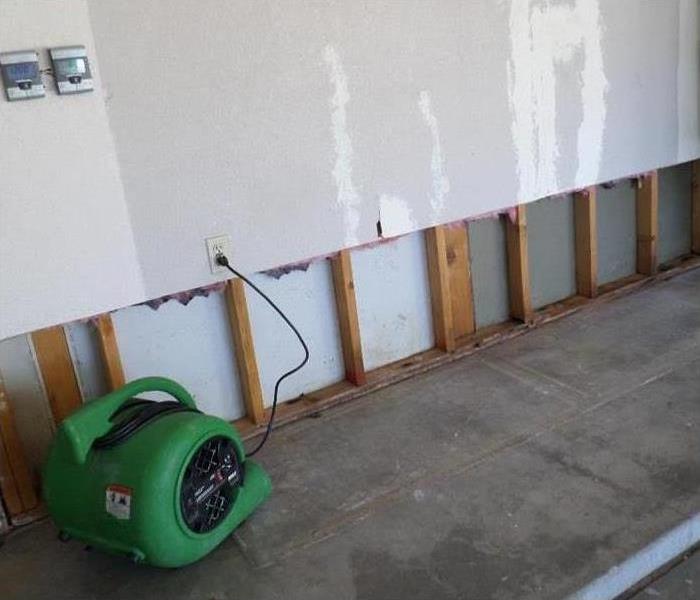 Drywall removed after water damage in Peoria, AZ
Drywall removed after water damage in Peoria, AZ
5 Steps of the Water Cleanup Process
A pipe burst in your home in Peoria, AZ, can leave you with a big mess. One of the first things you need to do when this happens is call the professionals. Your plumber and water cleanup specialists can help you get your home back to normal in five basic steps.
1. Tear Out Damaged Materials
The first thing technicians have to do is remove materials that bar access to the broken pipe, need to be restored or just aren't salvageable:
- Wall blocking the broken water line
- Saturated drywall and flooring
- Ruined carpets
- Soggy ceiling tiles
- Waterlogged belongings
2. Remove Excess Water
Flooding from a broken pipe can spill a lot of water into your home in a short amount of time. Technicians may have to extract standing water with industrial pumps to clear the space.
3. Dry the Remaining Structure
After the major damage has been removed, the remaining area is probably still wet from the pipe burst. Specialists dry the area as quickly as possible to prevent secondary damage such as mold growth. If the air in your home is particularly moist, they can also bring in a dehumidifier to bring humidity back to acceptable levels.
4. Restore Damaged Items
Your personal belongings that got caught in the flood may be able to be restored. Documents, pictures, electronic equipment, and furniture can often be fixed, even if they have a little water damage. After they are tried, technicians can determine whether they need to be repaired or thrown out.
5. Rebuild Structure
The last step of the restoration process is making your home look like new again. Restoration experts can make it look "Like it never even happened," by rebuilding walls and replacing flooring to match what is already there.
No homeowner wants to have a pipe burst in the house. If it happens, though, it is helpful to know what the restoration process is going to look like.
Disaster Preparedness Basics for Your Business
1/29/2020 (Permalink)
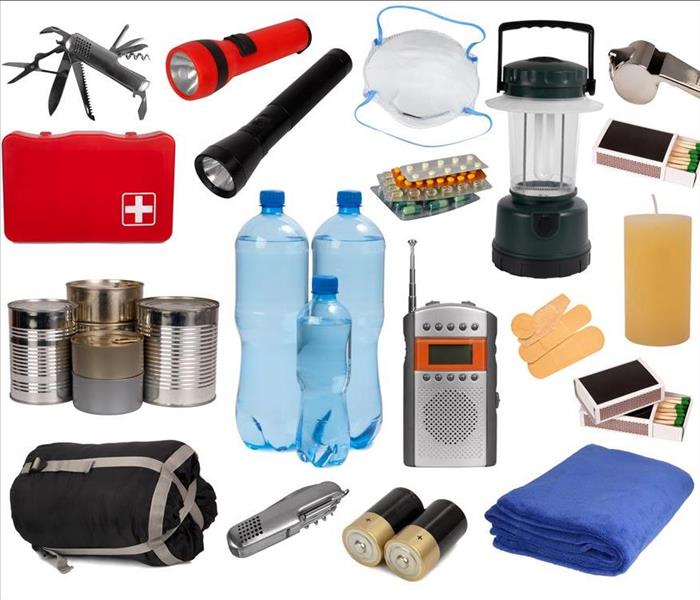 Prepare a disaster kit with first aid for your business in case of an emergency
Prepare a disaster kit with first aid for your business in case of an emergency
When a fire or flood threatens your building, you could be vulnerable to significant property damage. Severe weather events can quickly create emergency conditions. Formulating an emergency response plan for your company may help you avoid costly restoration due to a severe weather disaster.
Staff Preparation
When your business is disrupted by an emergency event, it takes time and costs money to return operations to normal. Developing a business continuity plan will help prepare your property and staff for a disaster and minimize lost revenue and profits. A BCP is a detailed emergency strategy that includes three primary elements:
- Conducting a business impact analysis can help you identify the potential effect a disruption may have on your corporate functions and processes.
- Selecting and training a business continuity team will establish a core group that is ready to activate your emergency response plan.
- Developing the systems needed for operating through an emergency disruption will enable your staff to quickly assume their continuity team roles and keep your business functioning.
A good business continuity plan is a detailed document that requires time and research to develop. Disaster preparedness websites and disaster remediation services generally provide detailed guides for creating BCPs.
Emergency Readiness Basics
While a BCP is crucial for addressing emergency conditions, a few common-sense basics should be in place at all times. Consider registering with local emergency notification services and preparing a disaster kit with first aid, water, food, flashlights, and batteries. Posting emergency contact information and a map with evacuation routes clearly marked are simple solutions that can be invaluable during a chaotic time.
If you have experienced an emergency disruption to your Weedville, AZ, business, you know how stressful and costly disaster remediation can be. A business continuity plan is your best chance for minimizing your losses. Understanding the elements of emergency preparedness and business continuity may help streamline the cleanup and recovery process should you experience a disruption.
What’s Causing the Noise in My Pipes?
12/12/2019 (Permalink)
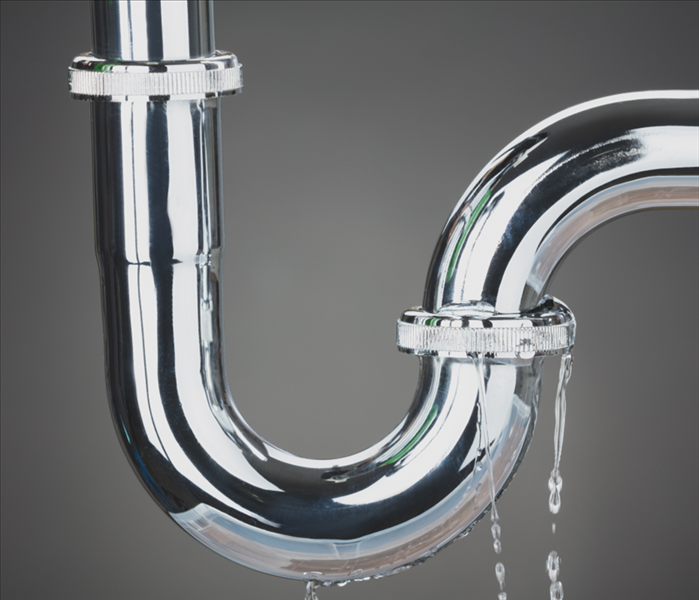 More water damages are caused by broken pipes
More water damages are caused by broken pipes
Reasons for Your Noisy Pipes
Hearing noisy water pipes after you flush your toilet or turn on a faucet can get annoying very quickly. It’ll also make you wonder what’s going on. Is it a serious problem? Is there a risk of a pipe break? It might not be a problem, but it’s an issue that’s definitely worth getting checked out. After all, if you have a pipe burst things can get really bad really fast. A few reasons for your noisy pipes could be:
1. Water Hammer
You might not realize just how fast water moves through the pipes when a faucet is opened. There’s actually a lot of force behind it. When the faucet is turned off the water is forced to stop abruptly, hitting the shut-off valve. This banging sound is called water hammer. Fortunately, there’s an air chamber (an air-filled pipe) located close to the faucet. This chamber absorbs the impact of the water hitting the valve. Over time air chambers can lose their effectiveness, causing the noisy pipe. Water hammer can damage pipe connections and joints.
2. High Water Pressure
Noisy pipes can be caused by excessively high water pressure. This pressure can result in damage to a pipe such as a pipe break. Professionals recommend that your home’s water pressure remains between 40 and 80 psi. Most homes these days have pressure regulators installed, but if your home doesn’t have one, you can have one installed.
3. Rattling Drain Pipes
Due to the amount of fast-moving running through drain pipes, if the pipes are loose they can create a rattling sound. These pipes can be stabilized, but aren’t likely to cause any damage if left as they are.
Noisy pipes in your Weedville, AZ, home can be an annoyance, but they could also signal a future problem. It’s best to be proactive and also to fix a broken pipe immediately should breakage occur. If your home sustains damage from a pipe break, you can count on water damage cleanup experts to help.
When To Worry About Noise From Your Water Heater
10/14/2019 (Permalink)
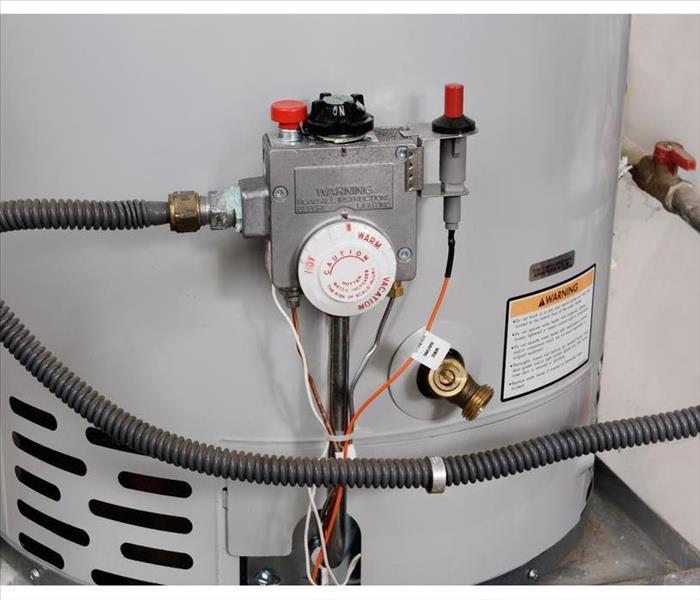 If your water heater is making loud noises, there is no need to panic
If your water heater is making loud noises, there is no need to panic
Common Noises From Water Heaters
A noisy water heater in your Peoria, AZ, home is not just an annoying inconvenience. It may also be the source of a larger problem. Common heater noises include:
- Tapping or Ticking
- Hammering or Knocking
- Humming
- Screeching or Screaming
Some of these sounds are indeed harmless. Others, however, could require immediate intervention to prevent the need for emergency restoration services in your home.
Normal Heater Noises
Your heater contains a heat trap that keeps the water flowing in the right direction. The trap may make a ticking or tapping sound. This is nothing to worry about, though it can be irritating at times. If you are sick of the noise, you can replace the trap with a dielectric nipple.
Hammering and knocking occur when the water going through the heater abruptly turns off. This can happen when you flush a toilet or use the dishwasher. While this doesn’t cause any harm to the water heater itself, the knocking could damage your walls. A water hammer arrester can eliminate the noise and protect the walls.
A humming or screeching heater is similarly easy to fix. Humming occurs when the element of the heater vibrates. Just tightening the element should reduce the noise.
Meanwhile, a heater screeches or screams when a valve is not opened all the way. Adjusting the valve in question should correct the issue.
Signs of Problems
A popping or cracking sound, however, may be a sign that sediment is collecting within the heater's tubes. Similarly, rumbling is evidence of the water stirring sediments stuck inside the tank.
Excess sediment buildup within the heater can lead to larger problems. You should thus regularly perform a water heater flush to keep the unit working properly.
You may also want to install a water softener within your pipes. This will reduce the minerals in your water that can create sediment.
If your water heater is making loud noises, there is no need to panic. Some of the sounds are fairly normal. Others can be fixed with some simple maintenance.
Water Damage Isn't Fun, Do What You Can To Prevent It
8/26/2019 (Permalink)
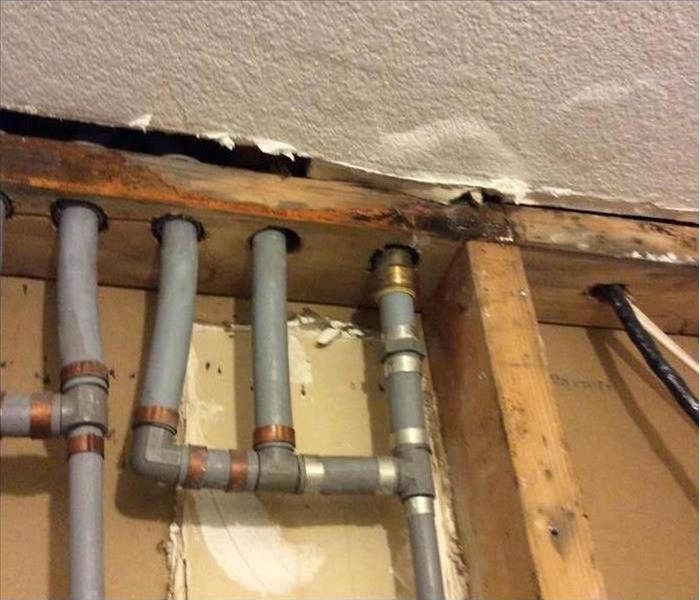 Leaking pipes in a Grand Manor, AZ home
Leaking pipes in a Grand Manor, AZ home
Tips To Help You Understand Water In Your Home
Repairing water damage can be a large undertaking, that often requires licensed remediation professionals in Grand Manor, AZ. To avoid going through a big ordeal, you should do your best to prevent it from happening in the first place. Here are some tips to help you understand water in home.
Appliances
Common sources of water damage are appliances that use water. If there is a faulty connection, cracked hose or old part there might be a leak. Routine maintenance and pipe cleanup should be observed. You may not notice a small, continuous leak at first. The most common culprits are:
- refrigerator
- dishwasher
- washing machine
- water heater
HVAC System
This stands for your heating, ventilation and air conditioning system. You should never see any water in home in or around these units. A single drip could mean something worse is building, like a leak or blocked drainage. Sometimes you may find water because of melting ice, which you should never see forming on your indoor coil. A dirty coil can also lead to leaks. You should have your system inspected at least twice a year, ideally before the winter and summer seasons, as these are the hardest on your system.
Plumbing
The most leak prone areas in your home are the bathroom and kitchen. Keep an eye out for any drips, water pooling or condensation. Be sure to check your ceilings for water stains, as well. Have your pipes inspected for condensation or corrosion about every six months, to head off a broken pipe. If you suddenly smell something musty, it is probably because of accumulating water, so do your best to search out the source. If problems like these are left alone too long, you could end up with mold.
Water is necessary for survival, but when it does not stay where it belongs, water in home can also be a problem. To prevent the larger issue of water damage, you should be aware of the signs and stay on top of maintenance schedules and inspections. Prevention is the best medicine!
How to Identify the Severity of Contaminated Water
6/13/2019 (Permalink)
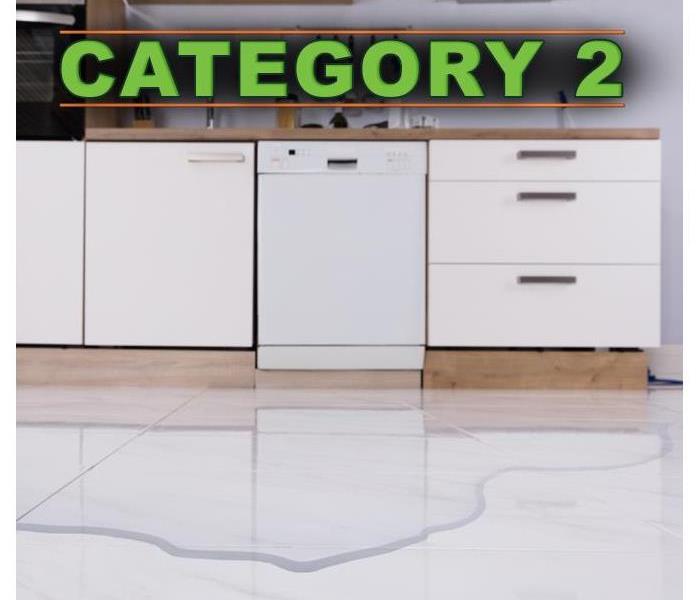 Category 2 water damage comes from a dirty water source
Category 2 water damage comes from a dirty water source
Learn How to Identify the Severity of Contaminated Water in Your Home
Of all of the types of in-home flooding in Grand Manor, AZ, a sewage backup can be one of the most severe. Sewer water entering your living space should be treated as an emergency situation and should be addressed immediately by professionals trained in sewer cleanup. Any time water damage occurs, the water contamination level can be measured on a scale of 1-3. For each degree of contamination, a greater threat is posed to your home and those living in it. Learn how to identify the severity of contaminated water in your home so you can approach the cleanup situation properly.
1st Degree Contamination
The first type of floodwater you may experience in your home comes from a clean water source. When a leak occurs from a sanitary water source like a pipe line or faucet, the contamination falls under the clean water category. While coming in contact with this type of water does not pose an immediate threat, its contamination degree can increase rapidly depending on factors such as the following:
- Length of exposure time
- Water temperature
- Contact with surrounding contaminants
2nd Degree Contamination
One degree higher, a category 2 contamination may be referred to as "grey water". This in-home water pollution comes from semi-clean water sources. A flooded toilet with water containing no feces, a dishwasher leak or laundry machine overflow are all cases of 2nd degree water contamination. Sewer cleanup of this type should be handled with care and thorough sanitation of the area should be addressed.
3rd Degree Contamination
Finally, the most serious cases of sewer backup are those known as "black water". Never make direct contact with this degree of sewer water. Untreated toilet water containing feces, water contaminated by harsh chemicals, or flood water from a storm or natural disaster should all be treated with great caution. Contact a local water cleanup and restoration company to assist you with category 3 sewer cleanup.
Can You Save Your Water-Damaged Electronics?
4/25/2019 (Permalink)
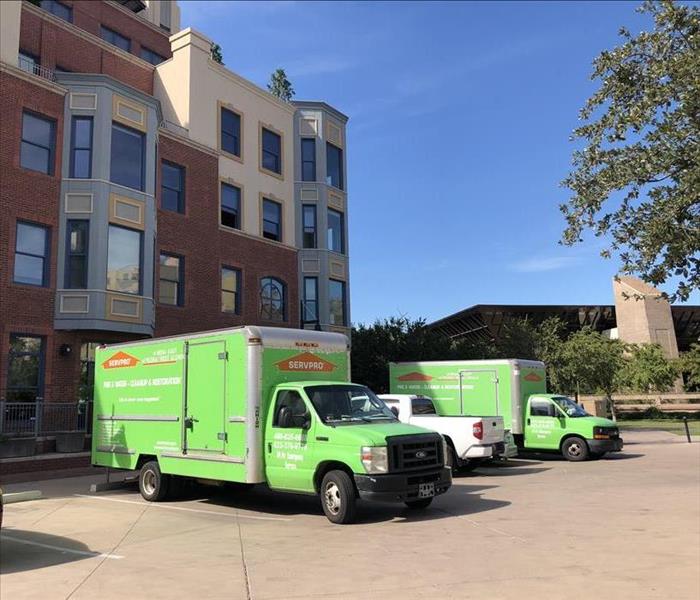 Contact a professional company to give you a hand
Contact a professional company to give you a hand
The effects of a flood can be terrible for your business. Water damage can do serious harm to carpet, drywall, documents and furniture. Then there’s the case of flooded electronics. You rely heavily on computers, servers, printers and other such equipment every day at work. If these items fall prey to unwanted water, you need to act quickly and get the right people on the case to clean and restore them.
What Can You Do?
If a flood starts in your Weedville, AZ, office, there are some immediate steps you can take to prevent further damage and to preserve your important equipment.
- Unplug all electronics (don’t turn on anything).
- Remove batteries from laptops.
- Disassemble hardware.
- Call a professional.
Simple Steps You Can Take on Your Own
If the electronic damage is light such as dirt or soot on the device, you can take a damp cloth the item and wipe away the materials. To prevent corrosion, you can put items in distilled water or alcohol.
When To Call the Pros
A professional electronic damage specialist can come to your aid when flooded electronics are beyond your ability to clean on your own. If a large flood or fire inflicted heavy damage on your computers, monitors, printers and other devices, an expert team can respond quickly and safely clean all of your items.
Why Call the Pros
A professional company will simply have much more experience and expertise when it comes to saving flooded electronics. The team will employ the most advanced equipment and methods to clean your electronics and salvage them for further use. The pros will clean the devices thoroughly and then will allow them to sufficiently dry so no moisture is trapped inside.
Water and electronics certainly don’t mix, but there are ways to clean your devices. If you think the situation is beyond your abilities, make sure you contact a reputable specialist to give you a hand.
The Best Ways To Prevent Water Damage
3/14/2019 (Permalink)
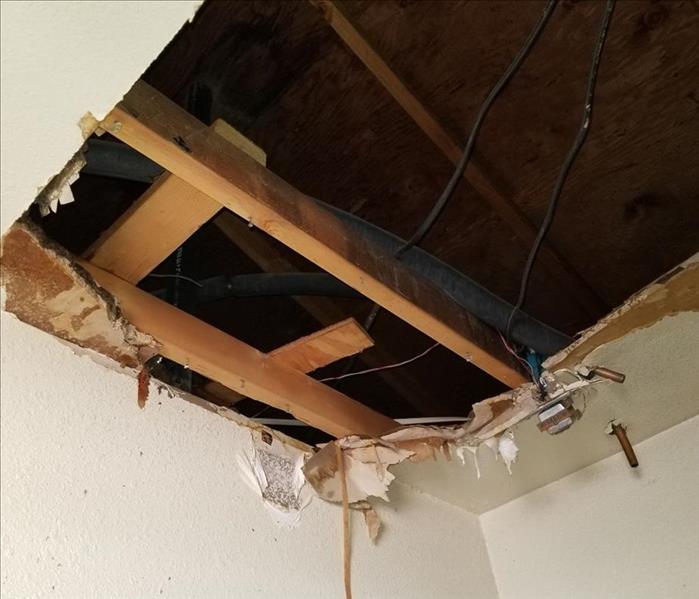 Pipe line on second floor causes ceiling damage in a Grand Manor, AZ home
Pipe line on second floor causes ceiling damage in a Grand Manor, AZ home
3 of the Best Ways to Prevent Water Damage
Water damage can be a major expense for homeowners in Grand Manor, AZ. Preventative measures are much more affordable and are possible for most major water in home risks. Here are three of the best ways to prevent water damage.
1. Check the Condition of Plumbing
Homeowners should be aware of the age and condition of pipes as well as the plumbing material. All of these factors may increase the risk of broken pipe. A homeowner can perform informal inspections to look for any signs of corrosion or leaks and identify places where pipes are exposed and may be prone to freeze. A plumber can provide professional insight into potential risks.
2. Monitor and Maintain Appliances
From the air conditioner to the dishwasher and washing machine, any appliance leak or malfunction can lead to standing water in home. Homeowners should look for any signs of built up condensation or problems with the water supply. Scheduling regular inspections with appliance specialists can be an easy way to stop potential problems before they start.
3. Inspect and Maintain Roofing
Roof damage and leaks are some of the most common causes of water damage. These leaks may be difficult to detect until extensive damage has already occurred. It is a good idea to regularly inspect the condition of a roof and contact roofing professionals if a roof sustains damage from high winds or storms.
These measures may not prevent every cause of water damage, but regular home inspections and maintenance can protect against some of the most common risks. Furthermore, homeowners insurance may be more likely to cover the cause of damage as well as the costs of cleaning up water in home if a policyholder maintains records of regular maintenance. Homeowners should contact a water damage restoration company if pipe cleanup or other damage mitigation is necessary at a residence in Grand Manor, AZ.
Don’t Panic Over Burst Pipes
2/26/2019 (Permalink)
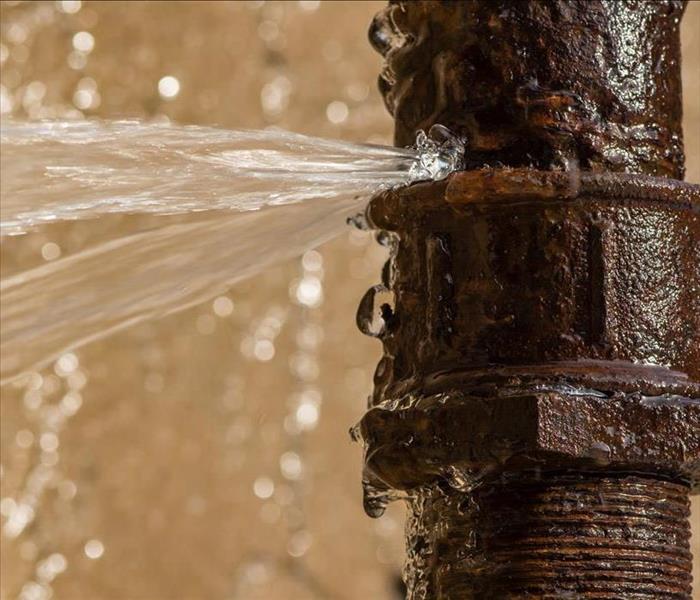 Water damage due to broken pipes is common.
Water damage due to broken pipes is common.
As winter comes in full force, burst pipes will become a reality for some homeowners. To wake up in the morning to a flood of water is a nightmare, to say the least. No matter how big or small the flood is, keep in mind that a little water can do a lot of damage in a short amount of time.
If you’re unlucky enough to be hit with water damage from a broken pipe, don’t fret, these three tips will help you through it.
- Calmly Assess Damages
As with any emergency situation, the key is to stay calm. Stress can make it difficult to make informed decisions or recognize the reality of the damages caused by the flood. First, look for the most visible signs of water damage on walls, rugs and furniture. If anything is saturated, bring in a restoration specialist to ease your mind and start damage control.
- Utilize Fresh Air
To dry out your home and protect against further water damage, you should air out your residence entirely. Open the windows and run a fan to get the air flowing through your residence. Additionally, you may use a dehumidifier to push the process forward.
- Clean Mold and Mildew
After the water cleanup, mold and mildew have to be eradicated. Detergents and bleach may be appropriate for the cleanup. You can scrub nonporous furniture and objects free of mold. However, for nonporous contents, they may need to be tossed out.
Water damage due to broken pipes is common. When it happens, however, you don’t have to go into a panic over what to do next. It’s important to stay calm to be able to appropriately assess all the damage done to your Peoria, AZ home. Once the damage has been fully gauged, you can begin the process to dry everything and address mold and mildew.
What Causes a Toilet to Leak When Flushing
1/18/2019 (Permalink)
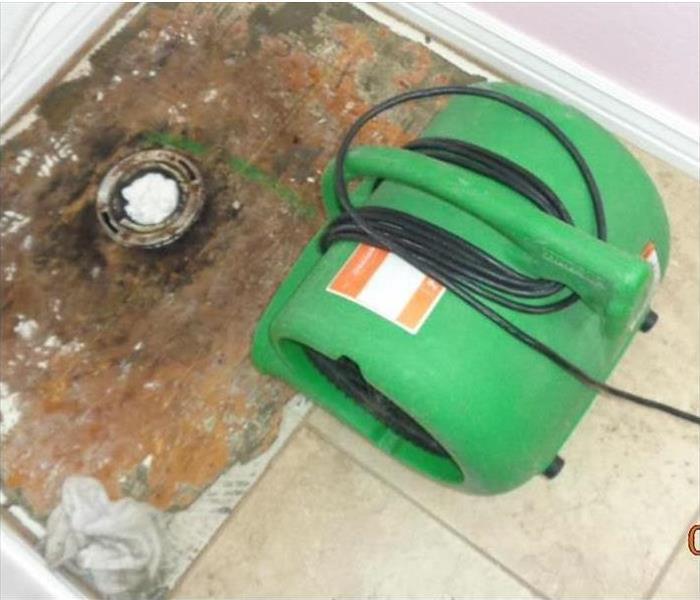 Bathroom damage, toilet was removed and space dried before reinstallation took place
Bathroom damage, toilet was removed and space dried before reinstallation took place
When you purchase a toilet in Weedville, AZ, you expect it to last for years without giving it much thought. Then one day, you start noticing a bit of a leak around the floor and you may get upset and not know what to do about it. There are a few things you can check to discover the cause of a leaking toilet.
What to Check When Your Toilet Leaks
- Tighten the closet bolts holding the toilet to the floor
- If water still leaks out, you may need a new wax ring
- Inspect the bowl and base for cracks, even hairline could leak
Over time the closet bolts (white porcelain covered bolts at base of toilet) can work loose, allowing water to seep out between the base of the toilet and the wax ring. This is a simplest fix for a bathroom leak. Bolts should be tightened a bit at a time alternating sides to avoid cracking or an uneven seal. If this is the problem, you shouldn’t see any more leaking.
If the leak isn’t stopped by tightening the bolts, you may need to replace the weakened wax ring. Turn off the water supply, remove the closet bolts and unseat the toilet from the floor. Remove the old wax seal and replace it. Set the toilet in place and retighten the bolts.
If you still experience a bathroom leak, the toilet itself may need to be replaced. Check for cracks or fissures in the interior of the bowl. You may resist the thought of replacing the fixture but a leaking toilet can cost much more in the way of water damage to your home. Even a slow and steady leak can cause mold or rot in the floor boards and presents the possibility water leaking into the floor below.
A reliable emergency water damage service in Weedville, AZ, can help to clean up and repair the damage “Like it never even happened.” Checking things out at the first sign of trouble can prevent the destruction of an ongoing leaking toilet and keep things sound and peaceful.
How to Respond to a Basement Flood
12/26/2018 (Permalink)
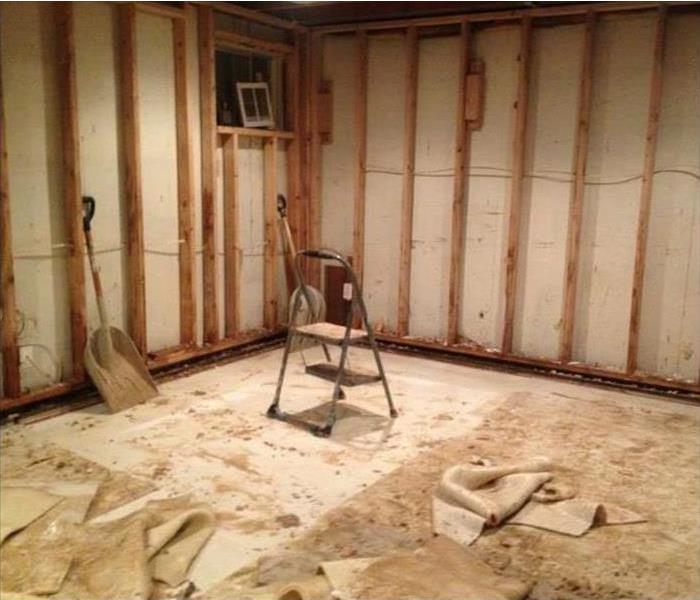 Basement flood in Glendale, AZ
Basement flood in Glendale, AZ
How to Respond to a Basement Flood
Under normal weather conditions and with a functional sump pump, a basement flood is a rare event. However, one should still be prepared to handle such a situation should it arise, given that the speed of response can directly affect property values and environmental conditions in the home.
1. Personal Safety
In the event that it becomes necessary to enter the flooded area, a number of precautions will be necessary. If the amount of water is lower than a few inches, making temporary walkways out of cinder blocks and boards may be enough to allow you to reach pertinent areas and begin the process of removing the remaining water. However, if the situation is severe and the electric and gas systems have been compromised by water intake, it is best to have these systems disabled in order to reduce electrocution and fire risks. Standing water can also incubate disease, so boots, gloves and respirators are advised during prolonged periods in an inundated home.
2. Restoring and Reconfiguring
If the sump pump is no longer functional, restoring it should be a high priority during a basement flood, especially if further inclement weather is expected. For the same reason, any exterior factors that tend to cause water pooling around entryways to the basement may need attention, such as the direction of downspouts. Some interior elements such as wet drywall or sensitive electrical appliances may need to be replaced. Carpets, carpet padding, and subflooring may need drying or replacement depending on the type. Many insurance coverage plans may require photographic documentation of the damages in order to process claims.
A basement flood in Glendale, AZ, can be a catastrophic event, but proper planning and appropriate tools can make managing the damage much easier. If the above steps are not feasible due to the risks involved, remember to contact a qualified cleanup service professional.
How To Identify Secondary Damage
10/10/2018 (Permalink)
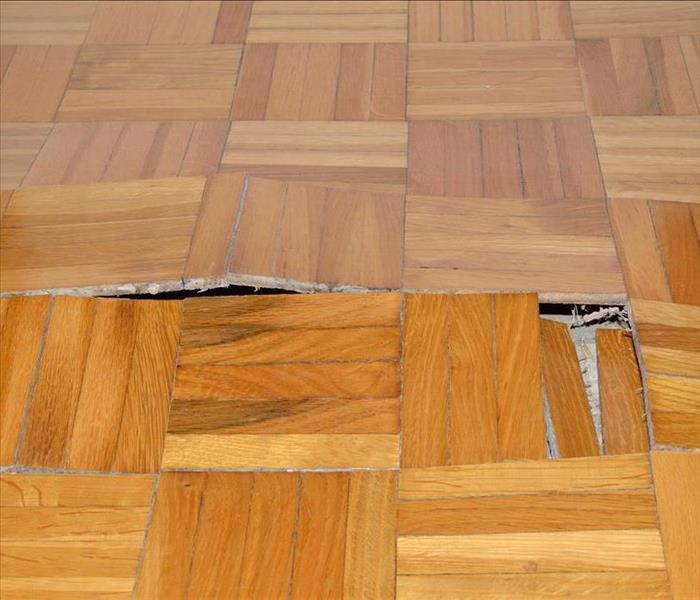 Wood floor damage in Glendale,AZ
Wood floor damage in Glendale,AZ
Primary water damage is relatively easy to pinpoint. A specific incident such as a broken pipe or malfunctioning device leads directly to the presence of water in a home. Secondary issues such as black mold may result if a homeowner does not immediately take action to mitigate the initial problem. It may be difficult to distinguish primary damage from secondary in an environment where both types of damage are present.
Primary Versus Secondary
Primary damage is directly caused by the original source of the damage. In the case of a roof leak or flood, primary damage occurs when items come into contact with the excess water.
Any damage that takes place after the initial incident or due to the conditions caused by this incident is secondary. This damage may occur if the primary damage is not promptly discovered or is improperly addressed.
Common Types of Secondary Damage
Primary damage can become compounded without adequate mitigation measures. If water is left to stand or conditions such as high humidity persist, you may have to deal with additional damage, including:
- The growth of black mold or other types of mold
- Buckled hardwood floors
- Metal corrosion
- Cracked plaster
- Released laminate or vinyl flooring
- Rotted wood
- Sagging sheetrock
Which of these conditions occurs depends on the types of building materials or contents that are exposed to primary damage. The severity of these conditions may vary depending on the duration of time and the severity of the primary damage.
Mitigation and Prevention
The best way to reduce the likelihood and extent of secondary damage is to promptly mitigate primary damage. Eliminate the presence of standing water and use a dehumidifier or ventilation to dry out air, building materials, contents, and surfaces. Keeping humidity levels low can help prevent the growth of black mold. In addition to this immediate action, your home can also benefit from the expertise of water damage restoration professionals in Glendale, AZ.
Light Fixtures and Leaking Water Do Not Mix
6/22/2018 (Permalink)
Electricity is one of the amazing marvels of modern life and it can allow you to bring entertainment, heat, and light into your home in Peoria, AZ. Most individuals don’t think much about the way electricity works or how it enters his or her home. Instead, they may simply flip on a switch attached to the electrical equipment and continue on their way. When the switch sends active current to dripping water in light fixtures, things could begin to go very wrong.
Potential Shocks
Water contains minerals that can carry the electricity far beyond the limits of the light fixture. By mixing the current and minerals, once the water begins to flow, the electrical current can cause the following problems:
• a shock from the light switch
• a shock injury from pooled water
• electrical shorts in wet wires
• popping breakers
• fires from electrical shorts
Since water acts as a possible conductor of electricity, it is best to stay away from all sources of possible electrical current near the dripping water
Averting Disaster
If water is dripping from the ceiling near a light fixture or fan, the first thing to do is turn the electricity off at the breaker box or service panel. The same can be true if a wet area appears on the ceiling near a light. By turning the active current off, you can alleviate possible fires and electrical shorts.
When water in light fixtures is actively dripping, turn the water off to the area. Removing the water can prevent damage from spreading and the ceiling from collapsing.
Once the electricity and water are off, call a water damage specialty team to clean, restore, and rebuild the area. The crew can locate the source of the water and repair the ceiling damage after evaluating the situation.
Saving Money
By acting quickly at the first sign of dripping water in light fixtures, you can often prevent a little water damage from becoming a flood disaster. By averting a possible calamity, you can also save yourself a great deal of money. For more information, visit http://www.SERVPROpeoriawestglendale.com/.
Your Insurance May Not Cover Your Broken Pipes, and Here’s Why
3/21/2018 (Permalink)
If your home was recently subject to a flood because of a broken pipe, you may want to know if your insurance coverage will pay for the cost of remediation. In many instances, the answer is yes, but in a few specific circumstances, the answer is a resounding no. Why, you wonder, would an insurance company deny a water damage claim? Here are a few reasons:
- You failed to fix a broken pipe
- You failed to fix a leaking pipe
- You failed to replace a broken pipe
- You failed to take preventative measures
Insurance Agencies Don’t Cover Negligence
As with all insurance policies, there are certain stipulations to coverage. For instance, some healthcare policies won’t cover preexisting conditions or any symptoms of said conditions, and an auto insurance provider will refuse to cover the cost of a broken window if you knowingly parked in a bad neighborhood. Homeowners’ insurance companies have their limitations as well, one of which is negligence on the part of the owners.
If the insurance adjuster discovers that the flood in your home was due to your failure to perform routine maintenance or to take reasonable preventative measures, you claim is likely to be denied. For instance, if you knew that a pipe was broken but didn’t fix it, damage caused by a surge of water through said pipe may not be covered. If a pipe burst because of a known leak down the line, any subsequent damage may not be covered. If you went on vacation in the middle of winter and did not insulate exposed pipes or set your thermostat to turn on at a certain temperature, damage may not be covered.
Fortunately, there are simple steps that you can take to ensure that all damage caused by a flood is covered. Talk with your Peoria, AZ, water restoration team about possible preventative measures.
Burst Pipes in Glendale, AZ
1/10/2018 (Permalink)
What should I do if there is water in my home?
It seems obvious, but the absolute first thing you do when encountering a pipe burst and water pouring through your home is to turn off the water. You need to have at your disposal a water meter wrench (you can get one for less than $20.00 from your local hardware or Big Box store).
Some houses and most commercial properties have a main water shut off valve inside the house, but most do not, and it is important to train everyone from teenagers to seniors how to use the wrench to cut off your water meter.
The difference between a 500 gallon water loss and a 5,000 gallon water loss is just a few hours. Shutting off the water quickly can save you hundreds of dollars.
Plumbing Problems in Your Home
1/10/2018 (Permalink)
When to call a plumber?
After a water damage call SERVPRO of Peoria/West Glendale at 623-376-9779 and your insurance agent. We can refer a competent plumber to repair any damage to water pipes. If you call a plumber first, beware of those who offer to have “someone they trust” come to remove the water and dry the house.
In Arizona it is not unusual for an independent water restoration company to pay referral fees up to $1,000 to the plumber who gets them the job. This fee is added to the cost of the job, which will ultimately drive up insurance rates. Our goal is to return your house to preloss condition as affordably as possible, which is why we are the preferred vendor of choice for the top brand insurance companies.
Water Extraction: Finding the Right Equipment for the Job
12/22/2017 (Permalink)
Water Extraction: Finding the Right Equipment for the Job
A flooded basement is an ordeal many have faced. Wet-vacs, fans and other equipment can be quite helpful to clean up the water if the damaged area is small, like in a residential property. However, removing 2 feet of water from the basement of a large commercial building is a very different problem. Wet-vacs are certainly not going to be the answer, so what should you do? You get the right tool for the job.
Buy or Rent
After a flood, many people will turn to their local home improvement stores, which carry a variety of water pumps and fans that are potentially viable solutions for smaller properties or basements. You can also choose to rent a sump pump or trash pump for bigger areas. It’s important to realize, however, that these machines just aren’t the answer for large areas with significant amounts of water.
Hire an Expert
Turning to water restoration experts is the smart move to handle large water extraction jobs because these professionals have the proper equipment. For example, many specialists will recommend using truck mounts and trash pumps to rid your commercial basement of water. The truck mount supplies the power of an industrial-size engine to a high-volume pump, allowing for faster extraction that is able to handle debris that may be in the water. Most importantly, these technicians are trained in the proper disposal of water that is categorized as toxic, such as flood water or sewage backups.
Think Beyond the Standing Water
Once standing water is removed, there is still water present in walls, porous materials, carpet and furniture. Water restoration experts keep industrial air movers and air cleaners at the ready. From a safety perspective, these tools can be a critical part of decontamination and mold prevention because they work so quickly.
Understanding the variety of water extraction equipment available will help any commercial property owner in Peoria, Arizona make the right decision when a flood hits. Visit http://www.SERVPROpeoriawestglendale.com for more information on water damage.
Events that Follow Immediately After Water Damage
9/15/2017 (Permalink)
Events that Follow Immediately After Water Damage
Whether water damage in your house has been caused by ground water, pipe break or any other malfunction, there are mitigation and corrective measures you need to do to restore normalcy. This post will guide you through the events that follow immediately a flood damage occurs.
Avoiding Additional Risks
In case the flood damage forced you to stay out of your house, make sure you stay safe after you return. Restoration experts warn that you should look for any visible structural damage such as cracked walls and holes before you take the next step. They also recommend you call a restoration company if you see any pipe leaks or signs that suggest supply line break.
In order to prevent further damage caused by water in your home or business, you must turn off all the electrical sources in the house. Do not handle electrical appliances if you are not properly insulated. Consult an electrician if you have to turn off the main electricity source while standing in water in the business or house.
Hiring Qualified Restoration Experts
Whether you have a major problem like a pipe break or supply line break or a small problem like flooded kitchen, you need to hire a reputable restoration company. A reputable company will come up with mitigation measures to reduce further damage and do water cleanup by drying the place and fixing damaged items.
Evaluating the Damage
Unless you are an experienced in water damage restoration, do not attempt to do any drying or water cleanup. Leave all the work to the water damage restoration experts. The first task of the experts will be to assess the damage caused by water in your business premises or home.
If you already have a flooded home, they will first come up with mitigation measures to prevent further damage before carrying out any assessments and water cleanup. They will examine the plumbing system to determine if there is any pipe break or supply line break. They will also look at every part of the flooded home to check what items have been destroyed and determine if rebuilding the house is an option.
Getting Rid of Water in the Flooded Home
Once the restoration company has assessed the extent of damage caused by water in your home or business premises, they will begin water cleanup and drying. Remember, the longer it takes to remove water in your business premises or home, the more damage it will cause. Their main objective will be to come up with active mitigation measures to prevent damages to the flooded home. They will pump out the water in the business premises or home until it recede below your house. If they are dealing with a small amount of water in the home, they may use wet-dry vacuums to remove the water and prevent further flood damage.
Drying and Cleaning Up the Debris
A flooded house will most likely have a lot of debris brought in by the flood water. These could be mud behind by the flood water in your home or business premises, foreign objects as well as snakes and rats. The restoration company will use various equipment to shovel the mud and spray down the affected areas with clean and fresh water. They will also take outside all the equipment and appliance affected by the flood and leave them there to dry for a given period.
Detecting and Removing Mold and Mildew
Molds usually thrive well in damp areas, especially near places affected by pipe breaks or supply line breaks. The restoration company has equipment that can easily detect mold at their early stages of growth and remove them. They will also ensure there is no future growth of mold by drying the area and spraying it with anti-mold chemicals.
It is important you hire flood damage restoration company to help bring things back to normalcy. Make sure the company you hire is certified and has a good track record in water damage restoration.
Visit http://www.SERVPROpeoriawestglendale.com for more information on water damage.
Restoring Your Home After a Flood
7/27/2017 (Permalink)
Restoring Your Home After a Flood
Water damage is one of the most serious forms of harm that can befall a home. Getting the water removed and beginning the restoration process as soon as possible is absolutely paramount. A professional restoration company can ensure that your property has the greatest possible chance of undergoing a complete restoration to its original state.
It is important to understand that a water damage event, such as a pipe break or a supply line break, is an extremely serious situation that must be resolved as soon as possible. You should never attempt to handle water damage yourself, as there is almost no way that the average homeowner has any of the necessary tools or skills to adequately handle a water damage event.
A professional restoration company, on the other hand, is able to use specialized, powerful equipment and high levels of expertise and experience to immediately begin the mitigation of further damage. Let's take a look at the general process through which professional restoration companies are able to turn potentially catastrophic situations into nothing more than a minor hassle.
As soon as you experience a supply line break, pipe leak or other form of water damage, it is absolutely imperative to immediately call a professional restoration company. They will send out a team of water cleanup experts to assess your situation and begin working towards the complete restoration of the premises. Remember, the first thing you must do is call. Waiting, even for a couple of hours, can have catastrophic long term consequences, as water in a home or water in a business begins seeping into structural components, carpeting and drywall the second there is a flood.
The next step in the flood damage mitigation process is for the team of water cleanup specialists to survey the property, assessing the extent of flood damage and formulating a game plan to remove the water in the home. This is an area where only highly trained professionals, using state-of-the-art equipment, can effectively carry out the water cleanup process.
Using such high-tech tools as hygrometers and infrared detectors, the water cleanup specialists will begin the mitigation process, seeking out any hidden water that has seeped into drywall or structural components. This is a crucial step, as flood damage that is left to seep into joists and beams can permanently compromise the property's structure.
The third step in the damage mitigation process is the extraction of water in the home water in the business. Again, this can only be done by a team of highly trained professionals. Using industrial-strength, submersible pumps as well as specialized drying equipment, not unlike that seen in car washes, the team will begin extracting the water in the home or water in the business. This typically begins within 15 to 30 minutes of the specialists arriving on site.
Next, the drying process can begin. The standing water in the business or home will have been removed by this stage. But many areas and items will still be soaked. Drying is carried out by the restoration company within the flooded home, using high-tech, sophisticated and extremely powerful drying units that can be cranked up to nearly the flash point of the materials within the flooded home. Using these systems, an entire flooded home can be completely dried within a matter of hours.
The final step in restoring the flood damage is a thorough cleaning and sanitization of the home. This ensures that no mold will be able to form and that any dank smells will be completely removed.
If you experience a supply line break or a pipe break, remember that literally every minute counts. A supply line break or pipe break can be completely resolved. But it must be acted upon quickly. Don't let a pipe break ruin the value of your property.
Visit http://www.SERVPROpeoriawestglendale.com for more information on water damage.
 Use fans and dehumidifiers to dry the area quickly, and do not allow standing water to remain in the area.
Use fans and dehumidifiers to dry the area quickly, and do not allow standing water to remain in the area.



 24/7 Emergency Service
24/7 Emergency Service



























